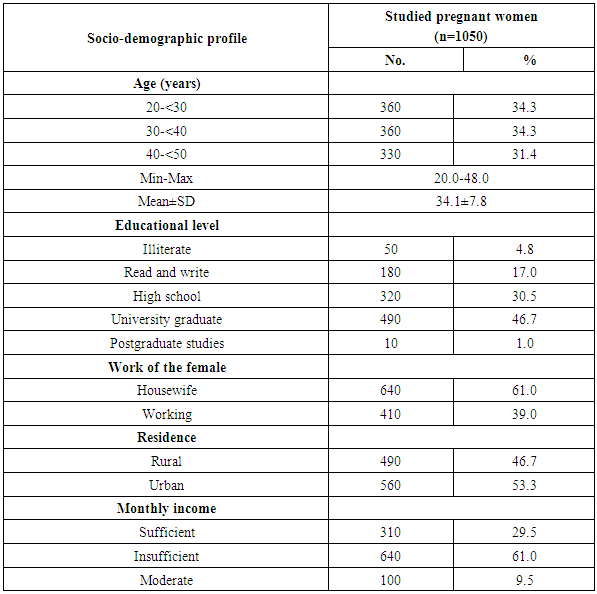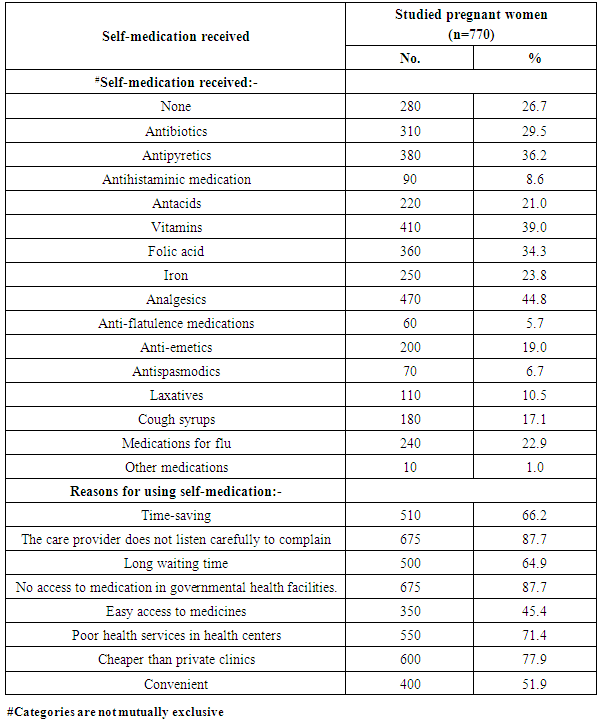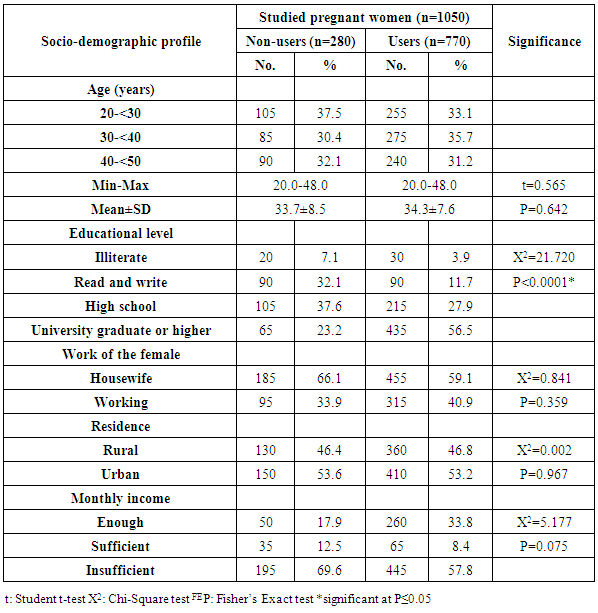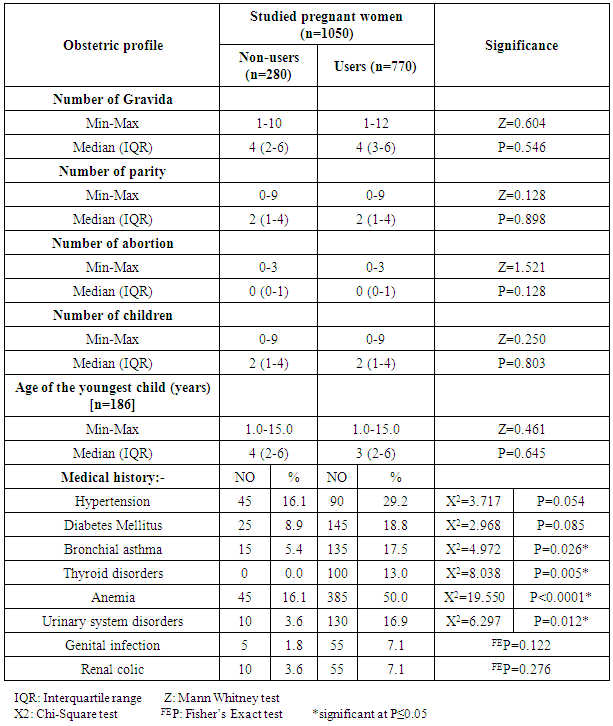-
Paper Information
- Paper Submission
-
Journal Information
- About This Journal
- Editorial Board
- Current Issue
- Archive
- Author Guidelines
- Contact Us
International Journal of Nursing Science
p-ISSN: 2167-7441 e-ISSN: 2167-745X
2018; 8(6): 99-107
doi:10.5923/j.nursing.20180806.01

An Assessment of the Factors Influencing the Use of over-the-Counter Medication during the Second Trimester of Pregnancy, Egypt
Mirfat Mohamed Labib El-Kashif1, Sheren Ebrahim El-Tahry2
1Lecturer of Maternity, Obstetric and Gynecological Nursing, Faculty of Nursing, Port Said University, Port Said, Egypt
2Lecturer of Medical-Surgical Nursing, Faculty of Nursing, Port Said University, Port Said, Egypt
Correspondence to: Mirfat Mohamed Labib El-Kashif, Lecturer of Maternity, Obstetric and Gynecological Nursing, Faculty of Nursing, Port Said University, Port Said, Egypt.
| Email: |  |
Copyright © 2018 The Author(s). Published by Scientific & Academic Publishing.
This work is licensed under the Creative Commons Attribution International License (CC BY).
http://creativecommons.org/licenses/by/4.0/

Background: the use of self-medication in pregnancy is considered a public health problem and very complex. The accuracy of this data is exceptionally remarkable as more clinical nurses announce self- medication used by pregnant women has ever created a challenge in antenatal care due to the potential fetal teratogenicity associated it is using. The uses of self -medications during pregnancy and the factors influencing it have not yet been fully investigated. Aim: The aim of this study was to assess the magnitude of the use of over-the-counter medication during the second trimester of pregnancy and its factors. Design: - A cross-sectional descriptive design from Jun to August 2018. Findings: - Out of 1050 respondents, 73.3% of pregnant women used self- medications during their current pregnancy. Analgesics were the most common medication used (44.8%), followed by vitamins (39.0%). The pharmacist was the most common source of knowledge (22.7%) and regarded as easy access. No access to medication in governmental health care facilities (87.7%), and the health provider did not listen carefully to complain (87.7%), were the main reasons mentioned for using self- medication. More than half of users had a high level of education, and 57.8% of them had an insufficient monthly income. Chronic diseases were a significant variable with use of self-medication during pregnancy. Conclusion & Recommendation: The use of self-medication is prevalent among pregnant women. The deficiency of appropriate recommendations related to pregnancy- medications are challenging for healthcare staff and clinical nurse who need sturdy evidence for treatment decision making.
Keywords: Over the counter medications, Pregnancy, Associated factors, Clinical nurse
Cite this paper: Mirfat Mohamed Labib El-Kashif, Sheren Ebrahim El-Tahry, An Assessment of the Factors Influencing the Use of over-the-Counter Medication during the Second Trimester of Pregnancy, Egypt, International Journal of Nursing Science, Vol. 8 No. 6, 2018, pp. 99-107. doi: 10.5923/j.nursing.20180806.01.
Article Outline
1. Introduction
- Pregnancy is a normal physiological condition associated with tremendous health problems such as morning sickness, heartburn, and constipation. Also, pregnant women may experience acute or chronic disease like diabetes mellitus, hypertension, or asthma, which need short or long-term medication therapy, so medication taken during pregnancy cannot be avoided entirely [1, 2]. Frequent medication use during pregnancy can cause an adverse effect for both the mother and then her fetus as well as birth teratogenic effects [3, 4]. The United States Food and Drug Administration has recognized five categories for drugs potentially- induced teratogenicity (A, B, C, D, and X). Commonly, category D or X drugs are measured potentially teratogenic drugs. Medications treatment for hypertension and seizures are classified as class D or X. Furthermore, there are many drugs can cause fetal damage, depending on the dose of the exposure and the timing of use [5]. Over-the-counter (OTC) drugs are medications sold and consumed without a health care profession prescription. The prevalence of OTC consumption is increasing more and more although it is a risk. The problem of OTC medication is widespread because it is interaction with other medicines, food, supplement, and drink and can cause death as well as [6].It was reported that about 66% of pregnant women used the OTC medication in Australia, Europe, North and South America [7]. The most prevalent type of over the counter medications (OTC) utilized by the pregnant women is analgesics and medication used for respiratory, gastrointestinal and skin problems [8, 9]. Maternal and fetal health during pregnancy needs medication- use stress regulations and rules because the drugs can pass the placenta and affect the fetal formation. Therefore, this medication should be prescribed and controlled by a specialist. Mostly, the information related to the use of drugs during pregnancy is deficient in antenatal clinics. Nurses have a crucial role in health education and counseling regarding the adverse effects of OTC medications during pregnancy. The nursing role will enhance the awareness and knowledge of the mother regarding medications, limited medications error as well as maintain the patient safety [10-12].It is confident that the problems facing OTC medication during pregnancy are the ignorance of the mother regarding the risks of this medication and lack of sufficient information from the doctor and pharmacist towards this drug. In a study done in Saudi Arabia, the pharmacists have not provided adequate medication-related information to the pregnant women [2]. For this, awareness of pregnant women toward the adverse effects of medications is essential.Significant of the study: -Medications taken during pregnancy can reach the fetus, especially during the first trimester of pregnancy and the beginning of the second trimester. Moreover, the Fifth week after fertilization appears to be the most critical time for a fetus development and organogenesis formation. During this critical period of organogenesis, the fetus develops rapidly and can influence by external factors such as medications and their subsequent adverse effects. Furthermore, the following adverse effects of taken medicines during pregnancy cannot appear directly after birth. Therefore, medication should be changed and taken accordingly to avoid the mother and fetus adverse effects [13, 14]. The most critical and challenging woman’s health issues are inadequate pregnancy safety information related medications, along with a need for appropriate treatment decision making [15]. Moreover, the epidemiological surveys regarding the prevalence of medications safety in pregnancy are still required, particularly among high-risk pregnant women [16].In the developing countries, patient poor health-seeking behavior, delayed antenatal follow up, low educational level of women as well as the shortage of latest health information for health care staff members, particularly insufficient health workers in health care centers. Furthermore, the inability of the health staff to get health requirements and lack of training of health care staff at the health center level could exacerbate illogical use of medications during pregnancy [17].It is noticeable that from the community health viewpoint, the OTC is more significant than prescription one because of its prevalence among the population. Besides, the database recorded about OTC medication- use during pregnancy is not available. So that, the women itself is the only valid source for getting data because she can remember the name of the medication she took and when she took it. Also, the study of the OTC medication safety in pregnancy is provoked especially the time of exposure and dose used [18]. Hence, the research conducted to assess the magnitude of the use of over-the-counter medication during the second trimester of pregnancy in Egypt. Accordingly, develop strategies to increase health-related this practice.
2. The Aim of the Study
- This study aimed to assess the magnitude of the use of over-the-counter medication during the second trimester of pregnancy and its factors. Accordingly, develop strategies to increase health-related this phenomenon.Design: - Research design: A cross-sectional descriptive design performed to accomplish the indicated aim.Sample/Participants: - The sample was collected from two cities in Egypt to increase the response rate (Port Said city and Damietta city). The study conducted in six health facilities from the two cities, which affiliated to Ministry of Health in Egypt, and selected randomly. The six health facilities are Port Said General Hospital, Port-Fouad first health center, and El Kuwait health center in Port Said city. The other health facilities were; Saad General Hospital, the First Qesm and Third Qesm health centers in Damietta. Only pregnant women who were in the second trimester of pregnancy were invited in the study from Jun 2018 to August 2018. The final study sample was 1050 which drawn by a convenient sample. After considering the proportional distribution of respondents, the sample was divided as the follows: 600 from the Damietta city and 450 from Port Said city. The researchers questioned each pregnant woman separately. At the starting of each interview, the purpose of the study and confidentiality of data was merely clarified to each woman. The data were collected four days per week from 9 AM to 12 PM. The researcher educates pregnant women to face to face regarding the risks of taking self-medications during pregnancy and the consequent complications of mother and foetus.Data collection: --An interview tools, it was arranged into four parts: Part (1): It included socio-demographic characteristics of pregnant women's as: name; age; educational level; women's work, income, residence. Part (2): obstetrics data; such as Gravidity, parity, abortion, numbers of children, and Age of the youngest child.Part (3): Medical disease encountered the pregnancy; diabetes mellitus, hypertension, bronchial asthma, anemia, genital tract infection, thyroid disorder…. etc.Part (4): It included questions regarding the use of the over the counter medications during current pregnancy; such as types of medication being used, knowledge of users regarding OTC medication, the source of knowledge, and reasons of using this medication.Ethical consideration: -The study established ethical approval from the Faculty of Nursing, Port Said University, Research Ethics Approval Committee.Data analyses:The raw data coded and entered into SPSS system files (SPSS package version 20, Chicago, USA). Analysis and interpretation of data conducted. The following statistical measures used: Descriptive statistics including frequency, distribution, mean, median, standard deviation, and interquartile range used to describe different characteristics. Kolmogorov – Smirnov test used to examine the normality of data distribution. Univar ate analyses including t-test and Mann Whitney used to test the significance of the results of quantitative variables. Chi-Square test and Fisher's Exact test were used to test the significance of the results of qualitative variables. The significance of the results was at the 5% level of significance.Validity and reliability/RigorPilot Study:The final study questionnaire was primarily tested in a pilot study on 50 women from health facilities in two cities. It used to assess the questionnaire consistency and clarity, and it has been shown to be reliable with a Cronbach's alpha as 0.86.Validity and Reliability: -Validity and reliability for the present study questioner were determined before sample collection. The reliability of the tools measured by Cronbach’s alpha test to test reliability, or internal consistency [19]. The validity of the tools content was assessed by a group of experts in obstetrics, medicine, pharmacology, obstetrics and gynecology-nursing specialist (Ph.D.).
3. Results
- Characteristics of the studied sample: -The mean age of the respondents was 34.1±7.8, and less than one-third (30.5%) had completed high school while 46.7% of them graduated from university. Less than two-thirds (61.0%) of respondents were housewives and had insufficient income. Also, more than one-half of respondents were alive in an urban area (53.3%). The majority of respondent were multigravida, 61% of them had no abortion. Less than half of respondent reported they have 1-2 children and more than one-third of them said the age of their youngest children was 1-<3 years (table 1) and (Table 2). Regarding the medical history of the studied sample, less than half of the respondent (41.0%) encountered anemia, followed by hypertension (25.7%) (Figure 1).
|
|
 | Figure 1. Medical history of the studied sample (n= 1050) |
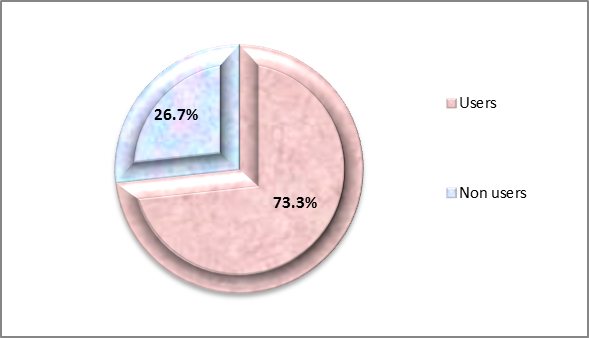 | Figure 2. Distribution of the studied sample according to the use of self-medication (n=1050) |
|
 | Figure 3. Knowledge of users regarding self-medication (n=770) |
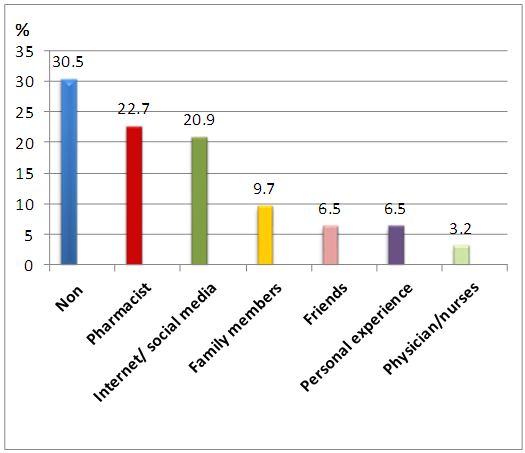 | Figure 4. Source of knowledge regarding self –medication among Users (n=770) |
|
|
4. Discussion
- The use of OTC medication differs through populaces [20]. In developing nations, pregnant women are consuming both prescription and nonprescription medicines without consultation [21]. Most of OTC drugs have been liked with adverse effects during pregnancy and the birth defect [22, 23]. Therefore, the use of the OTC medications in pregnancy is considered a public health problem [24]. Moreover, more studies to assess the prevalence of this phenomenon in pregnant women are still required, especially among high-risk pregnant women. Accordingly, this study engrossed on the assessment of the prevalence and factors influencing the practice of self-medication among pregnant women, in the region because no such surveys have been done so far.In the present result, the mean age of the respondents was 34.1±7.8. Nevertheless, this predictable because it is the appropriate and ideal mean age of childbearing. This result is relatively similar to the outcome of Khalaf et al. [25]. Also, most of the women completed secondary and university education. It has been distinguished that in developing world, women with high school education to more are more likely to follow their pregnancies than an illiterate one. Uneducated women may consider that pregnancy is a normal process and does not necessitate special care. This result is matching with the study result of Lamadah & Elsaba [26].Furthermore, less than two-thirds of respondents were housewives. This result is expected because employed women may not find the chance to follow their pregnancies in the government health facilities, especially during working times. This result is in line with the result of Khalaf et al. [25] who stated that more than three-quarters of the pregnant women in their study did were housewives. Also, more than one-half of respondents in the present study were live in urban area. This finding is supported by previous literature in Egypt [25]. Regarding obstetric profiles of the studied pregnant women, the present finding shows that the majority of respondent was multigravida and had more than two children. This result is noticeable because the total fertility rate (TFR) increased suddenly to 3.5 in Egypt according to the Demographic and Health Survey in Egypt 2014 [27]. Concerning medical history, the present finding portrays that, less than half of the respondent encountered anemia, followed by hypertension. The Obvious increase of anemia in the findings may due to increased parity, closed interval between pregnancies, and poor nourishment among pregnant women. These results are in line with Aljoher et al. [28] as the main antenatal maternal disease in their study was anemia, which was found in about half of the pregnant women and about 27.7% of pregnant women in El-Shatby hospital encountered hypertension.In the current study, 73.3% of pregnant women used the OTC medication during the current pregnancy. This finding is higher than the finding from that of southeast Ethiopia (15.5%) [29], and Nigeria (19.6%) [30], and Sharjah, United Arab Emirates, 40% [31]. However, the prevalence eminent in this study is lower than in USA findings as most women (82.0%) reported that they had consumed OTC medication in their pregnancies [32]. The differences might be due to alteration in sample settings and socioeconomic rank of the countries.In the present study, the analgesics, followed by vitamins, and then antipyretics were the commonly used OTC medications during current pregnancy, and a similar result was published in southeast Ethiopia and Peru, and Pakistan [29, 33]. Other literature in Egypt reported that 51% of pregnant women used folic acid, 39% used iron, and 26.6% used calcium as an OTC medication [12]. The present study finding is relatively similar to Hanafy et al. [12] as 34.3% of pregnant women used folic acid, and 23.8% of them used iron. It is recommended that folic acid is essential for pregnancy especially in the first trimester to prevent neural tube defects [34]. Besides, iron recognized as depression combat and can increase the resistant of mother to disease and stress. Moreover, it has a significant role in mother red blood cells formation as low iron levels are linked with low birth weight, premature delivery, and increased infant mortality [35, 36].More than two-thirds of respondent had knowledge regarding their OTC medications. This result can be predicted because most women who used OTC medications were in high education stage. So, higher education stage is associated with more acquaintance and awareness regarding health remedies and medicines, dependent in her decision, as well as have high self-confidence which increased the probability of the OTC- used- medication. Also, the pharmacist was the most common source of knowledge, followed by internet and social media. In this respect, George [37] reported that public pharmacists are the most reachable persona to provide health care to people. Also, he can give direct information regarding medications as well as can treat minor diseases. In the literature, it was stated that physician, internet, and friend or family were the most reliable sources on which a pregnant woman may request information about the use of OTC medication [38]. Furthermore, pregnant women can acknowledge medication information from pamphlet than either pharmacist or physicians [2].The main reasons mentioned for the use of OTC medication were, no access of medicine in governmental health facilities, moreover the health provider not listen carefully to complain, followed by the OTC medication is cheaper than visit private clinics. Egypt is similar to other parts of the world in which people had the abilities to use OTC medications for many motives. These included the cost increase of medical consultations, time shortage, more waiting time at the private clinics, absence of trust in medical knowledge from physicians — moreover that, personal experience with using medications and far distance of health services [9].Pregnant women who graduated from university and above are more likely to use OTC medication compared to lower educated women. This result may be the fact that the higher educated women are more likely to access the media and can get knowledge about how to use medication. This finding is similar to Aljoher tet al [38] result as it mentioned that well-educated women have a great ability to understand information about the medicine. While this is not in line with Zewdie et al. [29] who reported that the use of the OTC medication was higher among illiterate women; besides, more than two-thirds of women used OTC medication their income not enough. In this concern, Guille & Sen [39] mentioned that people with low socioeconomic status use medications recommended by relatives who previously used the same drug.The present study findings showed that chronic diseases were a significant variable with use of OTC medication during pregnancy. Asthma, thyroid disorder, anemia, and, urinary system disorders were significantly correlated with the use of OTC medications during pregnancy. The literature reported that 40% of pregnant women using OTC medication had a chronic disease. Also, pregnant women complain from chronic disease such as diabetes may be compliant with medication use during their pregnancies. Nevertheless, this may not be found for women without chronic disease [40, 41].
5. Study Limitations
- The first limitation is the unwillingness of the pregnant woman to talk about the personal information regarding self-medication and her desire to leave the health care facilities to perform other tasks. Second, the proportion of the predominance of high-educated women, which affects the result of the sample because it affects the degree of awareness and avoidance of risks. Therefore, it is necessary to conduct a study on the sector of non-educated so that the awareness of them towards this dangerous phenomenon can be raised.
6. Conclusions and Recommendations
- This study demonstrates that most of the pregnant women are practicing self- medication during their pregnancies. The main reason for following this practice so is the conveniently of self –medications, in addition to being cheap and easily accessible. Maternity health care staff should have sufficient knowledge to advise the pregnant woman to take off the use of self- medications because of its serious risk to the fetus and pregnancy. The strategic program to raise awareness of the pregnant mother regarding the dangers of this phenomenon should be prepared and broadcast through the media to prevent this practice as the media plays a significant role as it found in most of the houses. On the other hand, the finding of the present study will also be used as a standard for further studies.
ACKNOWLEDGMENTS
- The researchers would like to recognize all the participant women of the study and the health staff who assisted in data collection and patient control.
 Abstract
Abstract Reference
Reference Full-Text PDF
Full-Text PDF Full-text HTML
Full-text HTML